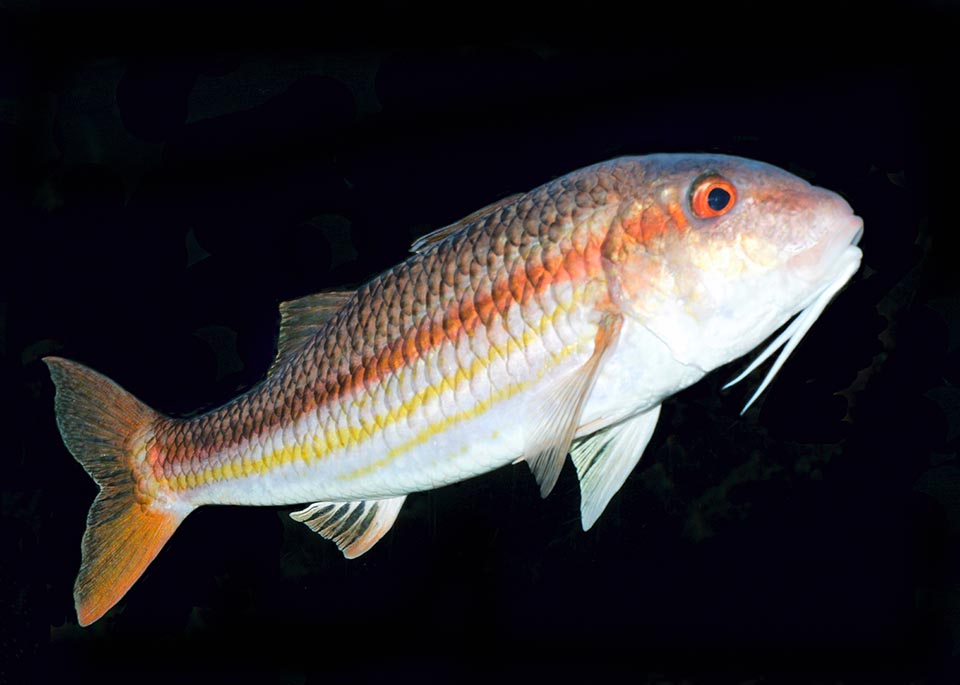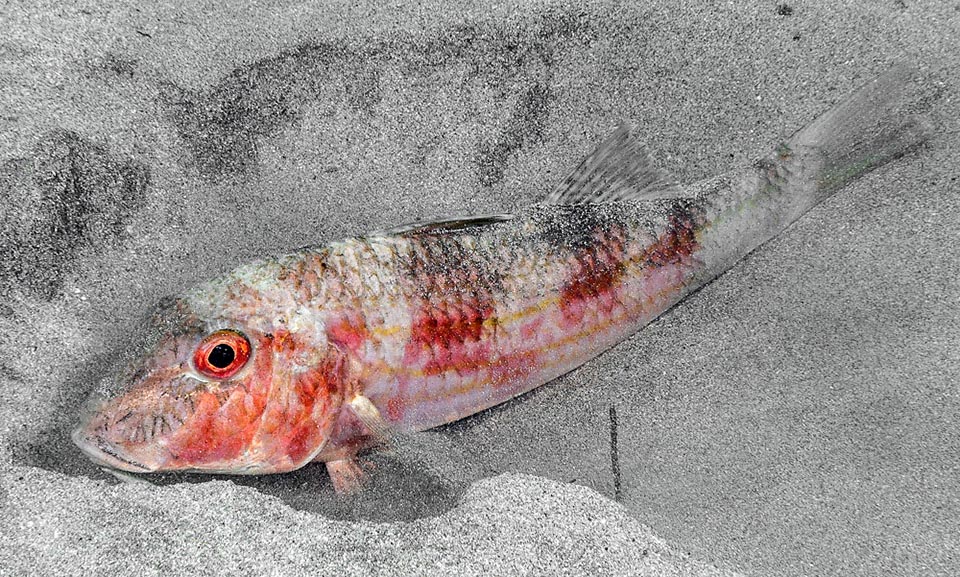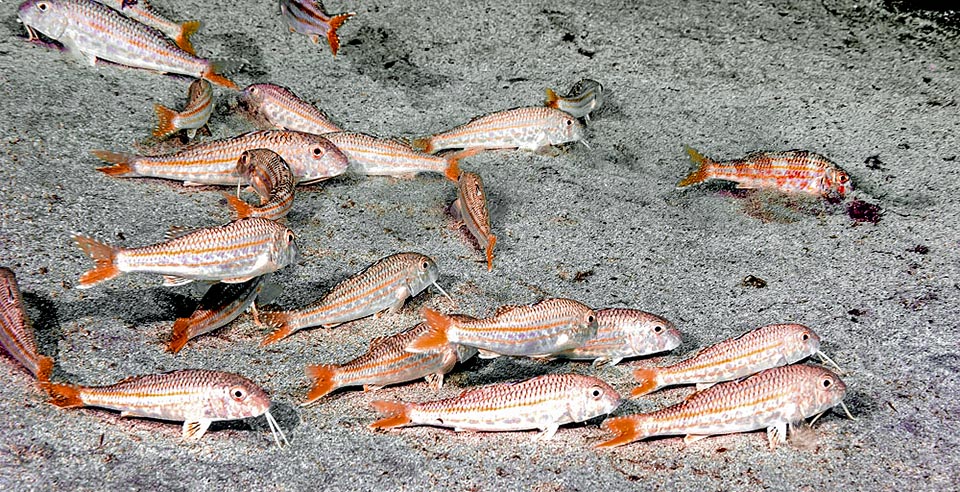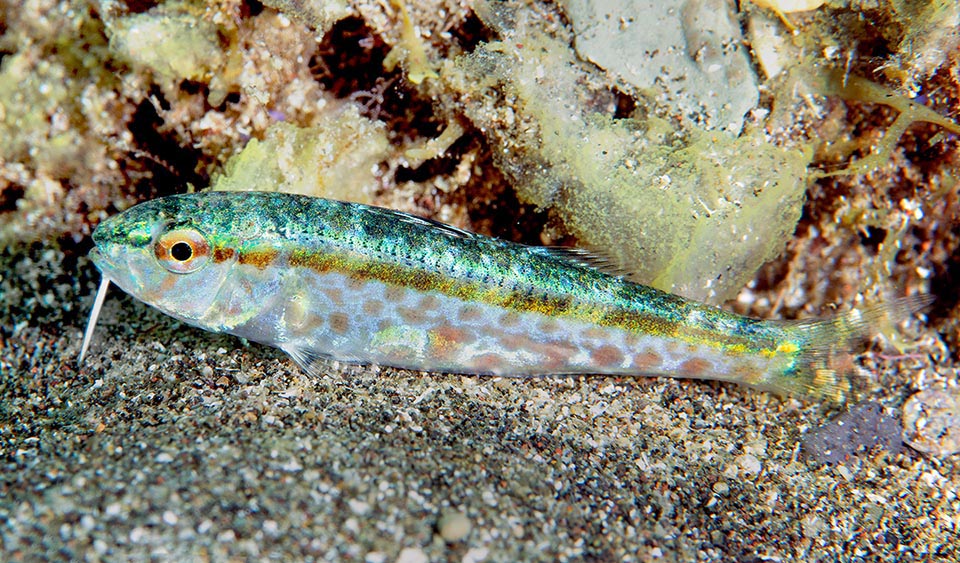Family : Mullidae

Text © Giuseppe Mazza

English translation by Mario Beltramini

The red mullet (Mullus surmuletus) is present in the Mediterranean, Black Sea and along the eastern Atlantic coasts from England and western Norway to Mauritania © Giuseppe Mazza
The Red mullet (Mullus surmuletus Linnaeus, 1758) belongs to the class of the (Actinopterygii), the ray-finned fishes, to the order of Mulliformes and to the small family of Mullidae which has 6 genera and around a hundred species.
The name of the genus Mullus was that given by the Romans to the mullet, fish vey much appreciated since the ancient times, so much that it is reported that Octavius purchased, for the emperor Tiberius, a huge specimen, weighing almost 2 kg, for the crazy amount of 5.000 sestertii.
The origin of the name of the species is rather complicated.
The prefix “sur-” should come from “sor-”, which, in the old French means “reddish”, and “muletus” comes from “mullet”, the name given to this fish by the French and the British.
In short, with the scientific name of Mullus surmuletus Linnaeus wanted to emphasize the European reputation of this unmistakably coloured fish.

Like a chameleon, acting on chromatophores, it can change color according to circumstances. The typical vermilion red of fishmongers appears only if it is traumatized, and fishermen, who know this well, when they extract the mullet from nets scratch them a little with their nails, so that they die with a more attractive color © François Libert
Zoogeography
It is present all over the Mediterranean, Black Sea included, and, after Gibraltar Strait, along the adjacent Atlantic coasts, from Mauritania to England and to the western part of Norway.
Ecology-Habitat
Usually, it lives close to the coast, and rarely dives under the 90 m, and, in spite of its Italian name, “triglia di scoglio” (= reef mullet), it is found more easily on the sand than on the rocks, less off the cost and at shallower depths than the similar Mud mullet (Mullus barbatus), even if we have to add, to be fair, that for some ichthyologists these two mullets should be actually the variants of one single species.
Morpho-physiology
Apart from the above-mentioned legendary specimen, it reaches, as a maximum, the 40 cm of length and 1 kg of weight.

At sunset, helped by their long barbels, they explore the seabed in search of crustaceans, molluscs, worms and, when it happens, young echinoderms and small fish © François Libert
It has two separate triangular dorsal fins, an anal fin almost specular to the second dorsal, a forked caudal fin, two pectorals, and, immediately under them, two ventral ones of analogous size.
The two long mobile barbels have an important tactile function for exploring the seabed looking for food.
More scarlet than the Mullus barbatus it differs for the red band and mainly for the yellow bands on the sides. But it is good to add that the colouration of the mullets depends from the contraction of the expansion of the chromatophores, the cells, located under the scales, containing the pigment. So, on the pale sandy bottoms, the mud mullet becomes pale yellow with the red of the band turning to dark brown, and in the underwater prairies the whole livery tends to the green.
It should be noted that the typical vermilion colour we find by the fishmonger, appears only when the animal is traumatized, for instance, if it is harpooned by a diver. And this is well known by the fishermen, who, when extracting the mullets from the nets, scratch them with the nails in order that they die with a more appealing colour.
Ethology-Reproductive Biology

A juvenile. Eggs are fertilized on the bottom but then rise to surface and larvae are pelagic. At 5 mm the hatchlings are semi-transparent, but due to life on the high seas they become increasingly blue. At around 3 cm they approach coasts and at 6 cm they reach the seabed with greenish tones, progressively taking on the colors of adults © Belén Caro
At dusk, the Mullus surmuletus is fully active. It goes around looking for crustaceans, molluscs, worms, and, if it’s the case, of some young echinoderm or some small fish. Unabated, it swallows the small preys together with the sand, which it spits immediately, quickly and very professionally.
It reproduces between April and August. The eggs are fecundated on the seabed and then surface becoming pelagic. The young, semi-transparent, when 5 mm assumes a blue colouration which will last till when they live in the high seas. When they reach the 30 mm, they get close to the coasts, but still swim on the surface with their pelagic livery they keep longer than the Mullus barbatus, until when they are about 60 mm long, when they go down to the bottom and assume progressively the adults tints. The Red mullet reaches sexual maturity at 15-26 cm in size and can live up to 11 years.
The fishing vulnerability index is moderate, currently scoring 42 on a scale of 100. Resilience is mediocre, with a possible doubling of populations in 1.4-4.4 years and the species is listed as “LC, Least Concern” in the IUCN Red List.
Synonyms
Mullus barbatus surmuletus Linnaeus, 1758; Mullus fuscatus Rafinesque, 1810.
→ For general information about FISH please click here.
→ For general information about BONY FISH please click here
→ For general information about CARTILAGINOUS FISH please click here.
→ To appreciate the BIODIVERSITY of BONY FISH please click here.
→ To appreciate the BIODIVERSITY of CARTILAGINOUS FISH please click here.
